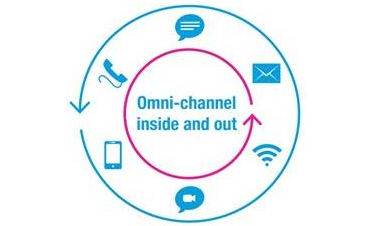It’s an oft-repeated truth that in our commoditized world, customer service is the most important differentiator. Increasingly, organizations are recognizing that a path to becoming customer-centric is through a comprehensive solution that facilitates a 360° view of the customer – an omni-channel approach that enables and encompasses all channels of interaction. The omni-channel experience is geared toward attaining a coherent and more holistic understanding of the customer through the sum total of interactions that take place with the customer in any channel.
The omni-channel approach is in line with how people regularly communicate, probably contacting their friends and associates in five or six different ways – from calling to texting to FB Messenger and more. When a customer wants to get in touch with a contact center, however, research [1] shows that even in 2016, he will most likely use a phone, talking to a “live agent” (66%) or write an email (14.2%). Why? Because that’s what contact centers mostly have available right now. While social media (2.4%) and webchat (4.7%) channels are becoming more frequent, options are still limited.
We know that no single method of interaction suits everyone or is appropriate in every situation. For example, 18-24 year olds prefer using mobile-based channels while those 65+ are partial to email. And, a question about the right size for a pair of shoes will probably lead to a webchat while a health insurance or banking concern will probably generate a call to a live agent or an email.
The disconnect in current contact center practice
Current contact center solutions do not enable an omni-experience. For starters, there’s no automatic sharing of information since there’s no single repository for all interactions. When an agent can’t provide the full extent of service because she doesn’t have access to the issue’s history if, say, this is an email interaction and the previous ones were voice and self-service, she is frustrated, the customer is angry, and the organization loses out on that interaction and in the future since it doesn’t have the tools with which to improve – creating a situation that looks like a custom-made deterrent to bottom line growth.
Add to that, the “omni” presence of social media and the risk that dissatisfied customers will lash out, it’s no wonder that contact centers are moving toward onmi-channel interaction. In fact 12% of centers define themselves as such, 24% as multi-modal, and 63% as multi-channel - indicating that awareness is clearly there.
Changing over to omni-channel
Now, how to take that fateful step to an omni-channel solution? Organizations that want to move down this path need to be sure they implement a technology solution whose infrastructure is designed and built to be omni-channel. Not only should it seamlessly incorporate any new communication channel an organization adds over time, but it must record all interactions – voice, text and video, etc. save them to a single repository and make them quickly available to meet a variety of purposes, including instantaneous reference for agents in the midst of an interaction; for customer analytics; agent training; and, regulatory compliance.
And, not only should an omni-channel solution be able to unify the view of the customer, it should also unify practice and policy by applying the same business rules and best practices to issues encountered through any channel.
In the hands of an organization committed to improving service, a comprehensive omni-channel solution is a valuable tool. With the expected growth of emails, webchat, what’s-up, social media messages, chat-bots, and self-service sessions in coming years, businesses should be able to capture them all and identify the customer journey. To capture the right elements and extract insights, interaction recording (and storage) capability are critical - since they are the repository for all voice and non-voice interactions. With adequate solutions, businesses have a far better chance of understanding and improving the customer experience.
[1] “The Inner Circle Guide to Omnichannel Customer Contact,” June 2016, ContactBabel, Newcastle-upon-Tyne, UK. /engage/eBooks/The-inner-circle-guide-to-Omni-channel-customer-contact-28


